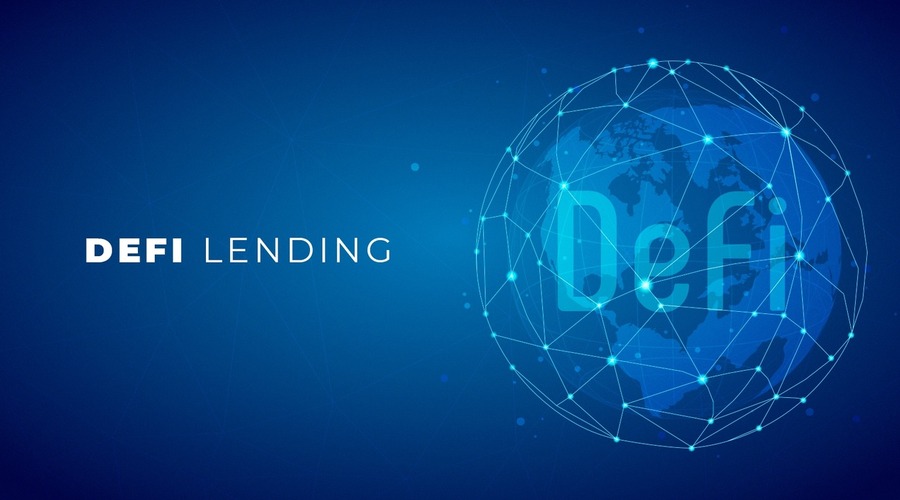The financial industry has seen a remarkable transformation over the years, with the advent of technology revolutionizing the way we manage and transact with our money. One such significant development in recent times is the rise of decentralized finance (DeFi) lending, which has emerged as a game changer in the financial industry. In this article, we will explore the concept of DeFi lending, its advantages, challenges, and its potential to reshape the traditional banking system.
Introduction
DeFi lending, short for decentralized finance lending, refers to a new financial system built on blockchain technology that enables users to borrow and lend funds without the need for intermediaries such as banks or other financial institutions. It operates on a peer-to-peer basis, allowing individuals to interact directly with each other through smart contracts. This decentralized approach offers several benefits over traditional financial systems, including increased accessibility, transparency, and security.
The traditional financial industry has long been dominated by centralized banking systems. These systems require individuals and businesses to rely on banks to facilitate transactions, manage savings, and provide loans. While they have served us well for centuries, centralized financial systems have their limitations. They often involve high transaction fees, slow processing times, and restricted access for underserved populations. Moreover, they are susceptible to censorship, fraud, and lack of transparency.
Understanding Traditional Financial Systems
To truly grasp the significance of DeFi lending, we must first understand the limitations of traditional financial systems. Centralized banking systems operate on a hierarchical model, where a central authority controls and regulates financial transactions. This authority oversees everything from account management to transaction verification.
However, this centralized control introduces several challenges. First, the reliance on intermediaries leads to increased costs and fees, making financial services less accessible and affordable for many individuals and small businesses. Additionally, the centralized nature of these systems exposes them to single points of failure, making them vulnerable to hacking, data breaches, and system outages.
Introduction to DeFi Lending
DeFi lending, on the other hand, operates on decentralized networks and relies on smart contracts to automate lending and borrowing activities. Smart contracts are self-executing contracts with predefined rules and conditions. They are built on blockchain platforms like Ethereum and ensure that transactions are executed only when the predetermined conditions are met.
The benefits of decentralized finance are manifold. Firstly, DeFi lending allows for greater financial inclusion by eliminating the need for traditional credit checks and collateral requirements. This enables individuals who were previously excluded from traditional banking services to access loans and credit. Moreover, since DeFi lending is built on blockchain technology, it provides a higher level of transparency and security, as all transactions are recorded on a public ledger and cannot be tampered with.
How DeFi Lending Works
DeFi lending platforms facilitate lending and borrowing activities by connecting lenders and borrowers directly. These platforms use smart contracts to automate loan origination, interest calculations, and repayment schedules. When a borrower requests a loan, the platform matches them with a lender based on predetermined criteria such as interest rates, collateral, and loan terms.
Collateralization is a crucial aspect of DeFi lending. Borrowers are required to lock up a certain amount of cryptocurrency or other digital assets as collateral to secure the loan. This collateral reduces the lender’s risk and acts as a guarantee for repayment. In case the borrower defaults, the smart contract automatically liquidates the collateral to cover the outstanding loan amount.
Another important feature of DeFi lending is the concept of lending pools. Lending pools are pools of funds contributed by multiple lenders, which are then used to fund loans to borrowers. This allows for greater liquidity and diversification, enabling lenders to earn interest on their funds while providing borrowers with a wider range of borrowing options.
Advantages of DeFi Lending
DeFi lending brings numerous advantages to the financial industry and its participants. Firstly, it promotes financial inclusion by providing access to financial services for the unbanked and underbanked populations. Since DeFi lending platforms do not rely on credit scores or traditional banking relationships, individuals with limited or no credit history can still access loans and credit.
Furthermore, DeFi lending offers global accessibility. As long as users have an internet connection and a digital wallet, they can participate in DeFi lending from anywhere in the world. This eliminates the need for intermediaries, such as banks or money transfer services, and reduces transaction costs and delays associated with cross-border transactions.
In addition, DeFi lending provides a higher level of transparency compared to traditional financial systems. All transactions are recorded on a public blockchain, making them easily auditable and verifiable. This transparency helps build trust between participants and reduces the risk of fraudulent activities.

Risks and Challenges
While DeFi lending presents exciting opportunities, it also comes with its fair share of risks and challenges. One of the primary concerns is the security of smart contracts. Smart contracts are not immune to vulnerabilities, and any flaws in the code can be exploited by malicious actors. Several high-profile incidents have highlighted the need for thorough smart contract audits and continuous monitoring to mitigate these risks.
- Smart contract vulnerabilities: The reliance on smart contracts exposes DeFi lending platforms to potential vulnerabilities and coding errors, which can be exploited by malicious actors.
- Regulatory concerns: The decentralized nature of DeFi lending poses challenges for regulators in enforcing consumer protection, anti-money laundering, and other financial regulations.
- Market volatility: Cryptocurrencies, which are often used as collateral in DeFi lending, can experience significant price fluctuations, resulting in potential losses for lenders and borrowers.
- Lack of insurance: Unlike traditional banking, DeFi lending platforms often lack comprehensive insurance coverage, leaving participants exposed to potential losses.
- Limited recourse in case of disputes: The absence of a central authority makes it challenging to resolve disputes and recover funds in the event of fraud or error.
DeFi Lending Platforms
Numerous DeFi lending platforms have emerged in recent years, offering various features and functionalities. Some popular platforms include Compound, Aave, and MakerDAO. These platforms provide users with the ability to lend or borrow a wide range of cryptocurrencies, earn interest on deposited assets, and participate in decentralized governance through voting mechanisms.
Each platform has its own unique features and benefits. For example, Compound is known for its algorithmic interest rate adjustments based on supply and demand dynamics, while Aave offers features like flash loans, which allow users to borrow funds without requiring collateral as long as the borrowed amount is repaid within the same transaction.
DeFi Lending Use Cases
DeFi lending has a wide range of use cases beyond simple borrowing and lending. One popular use case is stablecoin issuance. Stablecoins are cryptocurrencies pegged to the value of a stable asset, such as the U.S. dollar. DeFi lending platforms allow users to deposit their stablecoins as collateral and borrow other assets, leveraging the stability of stablecoins to access liquidity.
Yield farming and liquidity provision are also prominent use cases in DeFi lending. Yield farming involves providing liquidity to decentralized exchanges or lending platforms in exchange for earning additional tokens or interest. Liquidity provision ensures the smooth functioning of DeFi platforms and enables other users to access loans or trade assets seamlessly.
DeFi Lending vs. Traditional Banking
DeFi lending offers several advantages over traditional banking systems. Firstly, it provides greater speed and efficiency. Transactions on DeFi lending platforms are executed instantly or within minutes, whereas traditional banking processes can take days or even weeks to complete. This enables users to access funds quickly and respond to market opportunities in a timely manner.
Secondly, DeFi lending is often more cost-effective than traditional banking. Traditional financial institutions charge various fees for services such as account maintenance, wire transfers, and loan origination. In contrast, DeFi lending platforms typically have lower fees due to their decentralized nature and automated processes. This makes financial services more accessible and affordable for users.
Furthermore, DeFi lending puts users in control of their funds and eliminates the need to rely on intermediaries. Users retain ownership of their assets throughout the lending process, and transactions are governed by predefined smart contracts rather than the discretion of a centralized authority. This gives individuals greater autonomy and reduces the risk of censorship or arbitrary decisions.
Future Implications of DeFi Lending
The rise of DeFi lending has the potential to disrupt traditional banking models and reshape the financial industry as a whole. As decentralized finance continues to gain traction, it is likely to challenge the dominance of centralized banking systems by offering more inclusive, efficient, and user-centric financial services.
Furthermore, the integration of DeFi lending with traditional finance is an area of growing interest. Several financial institutions are exploring partnerships and collaborations with DeFi platforms to leverage the benefits of decentralized finance while ensuring compliance with regulatory requirements. This hybrid approach could lead to the emergence of new financial products and services that combine the best of both worlds.
In terms of innovation and growth, DeFi lending opens up a world of possibilities. The ability to program financial agreements through smart contracts allows for the automation of complex financial instruments and the creation of new financial models. This paves the way for innovative solutions in areas such as decentralized insurance, prediction markets, and decentralized asset management.
Conclusion
DeFi lending represents a paradigm shift in the financial industry, offering a decentralized and inclusive alternative to traditional banking systems. By leveraging blockchain technology and smart contracts, DeFi lending platforms enable individuals to access loans, earn interest on their assets, and participate in the global financial system without relying on intermediaries. While challenges and risks exist, the potential for greater financial inclusion, transparency, and innovation makes DeFi lending a game changer in the financial industry.
FAQs
Q: What is the minimum amount required for DeFi lending? A: The minimum amount required for DeFi lending varies depending on the platform and specific lending pools. Some platforms have minimum deposit requirements, while others allow users to participate with any amount they desire.
Q: How secure are DeFi lending platforms? A: DeFi lending platforms aim to provide a high level of security through the use of smart contracts and blockchain technology. However, it’s important to note that no system is entirely immune to risks. Users should conduct their own research, choose reputable platforms, and be mindful of potential vulnerabilities and scams in the DeFi space.
Q: Can I earn interest on my cryptocurrency holdings? A: Yes, one of the key advantages of DeFi lending is the ability to earn interest on deposited assets. By lending out your cryptocurrency holdings through DeFi platforms, you can earn interest based on the demand for borrowing and the agreed-upon interest rates.
Q: What happens in case of a smart contract failure? A: Smart contract failures can have various consequences depending on the specific situation. In some cases, it may result in financial loss or the inability to execute a transaction as intended. It’s crucial to understand the risks associated with smart contracts and choose platforms that undergo thorough security audits and have mechanisms in place to address potential failures.
Q: Are there any regulatory frameworks for DeFi lending? A: The regulatory landscape for DeFi lending is still evolving, and there is no unified global framework at present. Different jurisdictions may have different approaches to regulating decentralized finance. It is advisable for users to familiarize themselves with the regulatory requirements and consult legal professionals if necessary.
I’m known as one of the best Crypto Authors in the market. My work has been featured in numerous publications, including The Wall Street Journal, Forbes, and Barron’s. I’m a regular contributor to CoinDesk and have been a guest on CNBC, Fox Business, and Bloomberg TV.



